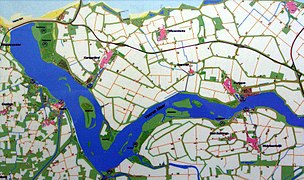
A polder is a low-lying tract of land that forms an artificial hydrological entity, enclosed by embankments known as dikes. The three types of polder are:
- Land reclaimed from a body of water, such as a lake or the seabed
- Flood plains separated from the sea or river by a dike
- Marshes separated from the surrounding water by a dike and subsequently drained; these are also known as koogs, especially in Germany
The Delta Works is a series of construction projects in the southwest of the Netherlands to protect a large area of land around the Rhine–Meuse–Scheldt delta from the sea. Constructed between 1954 and 1997, the works consist of dams, sluices, locks, dykes, levees, and storm surge barriers located in the provinces of South Holland and Zeeland.
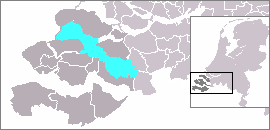
The Eastern Scheldt is a former estuary in the province of Zeeland, Netherlands, between Schouwen-Duiveland and Tholen on the north and Noord-Beveland and Zuid-Beveland on the south. It also features the largest national park in the Netherlands, founded in 2002.
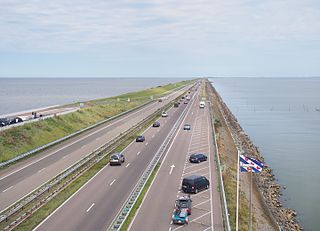
The Afsluitdijk is a major dam and causeway in the Netherlands. It was constructed between 1927 and 1932 and runs from Den Oever in North Holland province to the village of Zurich in Friesland province, over a length of 32 kilometres (20 mi) and a width of 90 metres (300 ft), at an initial height of 7.25 metres (23.8 ft) above sea level.

Zuid-Beveland is part of the province of Zeeland in the Netherlands north of the Western Scheldt and south of the Eastern Scheldt.

The Afgedamde Maas is a former distributary of the Maas River in the Dutch provinces of North Brabant and Gelderland. The Maas splits near Heusden with one channel flowing north until its confluence with the river Waal to form the Merwede, while the other channel continues west as the main distributary of the Maas.
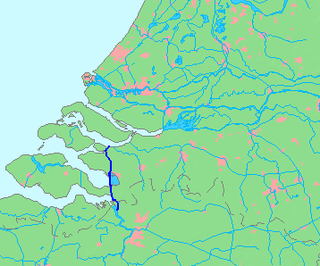
The Scheldt–Rhine Canal (Schelde-Rijnkanaal) in Belgium and the Netherlands connects Antwerp with the Volkerak, and thereby the Scheldt with the Rhine.

The Canal through Walcheren in the Netherlands crosses the east of Walcheren. It connects the Westerschelde and the Veerse Meer.

The Bijlands Kanaal is a canal in the Dutch province of Gelderland, near the Dutch-German border. It is currently by far the most important river-stretch of the Rhine when that major river enters the Netherlands.
The Veerse Gat or Veeregat was the sea channel between Walcheren and Noord-Beveland islands in Zeeland in the Netherlands. In 1961 as part of the Delta Plan it was blocked off by the Veerse Gatdam and made into an inland lake called Veerse Meer.
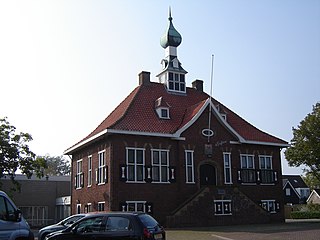
Wolphaartsdijk is a village in the Netherlands, located in the province Zeeland. Wolphaartsdijk is part of the municipality of Goes. In 2009 the village had 2109 inhabitants.

The Ministry of Transport, Public Works and Water Management was a Dutch ministry responsible for water management, public and private transport and infrastructure. It is now part of the Ministry of Infrastructure and Water Management.

Rijkswaterstaat, founded in 1798 as the Bureau voor den Waterstaat and formerly translated to Directorate General for Public Works and Water Management, is a Directorate-General of the Ministry of Infrastructure and Water Management of the Netherlands. Its role is the practical execution of the public works and water management, including the construction and maintenance of waterways and roads, and flood protection and prevention. The agency was also involved in the construction of big railway projects such as the Betuweroute and the HSL-Zuid.
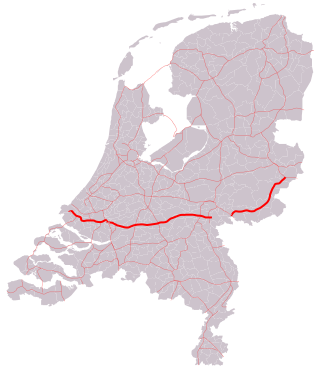
The Dutch A15 motorway is a set of two motorways in the Netherlands, the A15 and the A18.
The Sloedam was a dam, connecting the Dutch islands Zuid-Beveland and Walcheren near the town of Arnemuiden. Before the dam was constructed, these islands were separated by a stretch of water called the Sloe. The Sloedam was constructed in 1871 for the railway connection between the towns of Flushing and Roosendaal, the so-called Zeeuwse Lijn. After World War II, the areas to the south of the dam were poldered. Since the Veerse Gat estuary was closed off by the Veerse Gatdam in 1961, the Sloedam no longer functions as a primary defense against the sea.
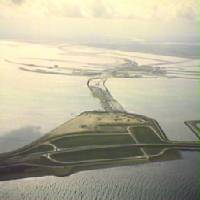
The Philipsdam is a dam constructed as part of the Delta Works in the Netherlands. It separates water of the lakes Krammer and Volkerak from the Oosterschelde. The dam connects the Grevelingendam to Sint Philipsland.

The Voorne Canal is a former ship canal on Voorne-Putten in South Holland, the Netherlands. It was the first canal to connect Rotterdam to the sea. Construction of the canal started in 1826 and was completed in 1829. Until the completion of the Nieuwe Waterweg in 1872 it was the main connection from Rotterdam to the sea for ocean going ships.

The Volkerakdam or Volkerakwerken is the name given to a group of hydraulic engineering structures located between Goeree-Overflakkee and North Brabant in The Netherlands. The works are not a single dam, but are composed of three distinct structures: a dam between Goeree-Overflakkee and Hellegatsplein, a series of locks from Hellegatsplein to North Brabant, and a bridge from Hellegatsplein to Hoekse Waard. The works cross three separate bodies of water: the Haringvliet, Hollands Diep and Volkerak. The works together comprise the fifth project of the Delta Works.
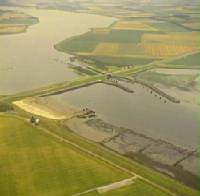
The Zandkreekdam is a dam in The Netherlands which connects Zuid-Beveland with Noord-Beveland, and separates the Oosterschelde from the Veerse Meer. A navigation lock in the dam permits shipping connections to Middelburg and Vlissingen, via the Veerse Meer and the Walcheren navigation channel. The Zandkreekdam is 830 metres in length, and was the second project to be constructed as part of the Delta Works, having been proposed by Johan van Veen as part of the Drie-Eilanden Plan which originated in 1930s.



